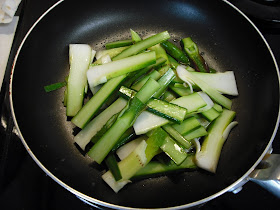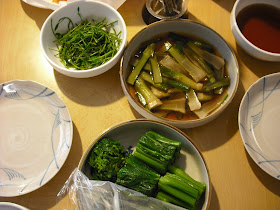First, at around 3 o'clock, my son came home with this:
今晩はゆったりと過ごそうと思ってました。妻には刺身とビールを買ってくると言っておきました。しかし、時には、子供が何をしでかすか分かりません。特に、その子供が自然を愛する、きのこを愛する、そして山菜を愛する息子の場合は。
まずは3時頃、息子はこれを持ってきました:

Udo (Aralia cordata). My son and I discussed what to do with them. Conclusions: Tempura for the leaves and kinpira for the stems.
ウドです。息子と私はどうしようか話し合いました。結論は:葉は天ぷらに、茎はキンピラに。
This means that I had to give up my initial plan to have a slow evening.
ということは、のんびり夜を過ごそうという当初の計画は諦めざるを得ませんでした。
Kinpira in the making:
キンピラを作成中:

Later seasoned with 40 ml soy sauce, 40 ml mirin, and 20 ml sake.
醤油40 ml、味醂40 ml、お酒20 mlで味付けしました。
He later came home with this:
後でこれを持って帰ってきました:

Chickweed. He said he wanted to have it boiled and have it as ohitashi.
はこべです。息子は、茹でて、おひたしとして食べたいと言いました。
He also brought me this:
またこれも持ってきました:

Young leaves of daylily. I know. He told me yesterday that he wanted to get some young leaves of daylily today. But I didn't expect that he would bring me other sansai.
カンゾウの若葉です。分かってます。昨日、カンゾウを今日取って来たいと言ってました。でも、他の山菜も持ってくるとは思いませんでした。
Besides, my wife came home with this:
その上、妻がこれを持って帰ってきました:

Leafy vegetable called "touna" (lit. winter green) here in the Uonuma district of Niigata. The photo shows only the half of what she got from her father.
新潟の魚沼地域では「冬菜」(とうな)と呼ばれる葉野菜です。写真に載っているのは、妻が実の父からもらった量の半分だけです。
I washed, drained, and boiled them all.
全部私が洗い、水を切り、ゆでました。
I stir-fried half the young leaves of daylily, together with some ham and eggs. I boiled the other half to have it as ohitashi.
カンゾウは若葉の半分は、ハムと卵と一緒に炒めました。残りの半分は茹でて、おひたしとして食べました。

Surprisingly, my son came home with yet another sansai:
驚いたことに、息子はまた別の山菜を持ってきました。

Young shoots of three-leaf akebia, called "kinome" here in the Uonuma district. ("Kinome" usually means young leaves of sansho.) Kinome are usually boiled and eaten as ohitashi.
三つ葉アケビの若芽です。魚沼地域では「木の芽」と呼ばれます。(通常、「木の芽」とは、山椒の若葉のことです。)木の芽は通常、茹でて、おひたしとして食べます。
Leaves of udo, ready to be tempura'ed:
天ぷらにする準備のできた、ウドの葉:

Boiled kinome, udo kinpira, and boiled touna:
茹でた木の芽、ウドのキンピラ、茹でた冬菜:

The dipping sauce for tempura was a 4:1:1 mixture of dashi, soy sauce, and mirin, as usual.
天つゆは、いつも通り、出汁、醤油、味醂を4:1:1で混ぜたものです。

I also made kakiage, with sakura ebi (dried small shrimp), onion, and carrot.
桜えび、玉ねぎ、ニンジンで、かき揚げも作りました。


When making tempura, be sure to use hakuriki ko (low-gluten flour), like these:
天ぷらを作る時は、このような薄力粉を使うようにして下さい。

And, use vegetable oil, like canola oil.
そして、菜種油(キャノーラ油)のような植物油を使って下さい。

I also made sweet potato tempura.
サツマイモの天ぷらも作りました。

I kept working in the kitchen from around 3:30 to almost 6:30! I will have sashimi and beer for supper tomorrow evening!
台所で3:30頃から6:30頃まで働き続けました。明日の夕飯には刺身を食べ、ビールを飲みます!
Nice to see your son has such a healthy interest in food. Like father like son!
ReplyDeleteChee Fai: Thanks for your comment. The problem is that my son's interest in mushrooms, sansai, and others far exceeds mine!
ReplyDeleteThat is so great that your son is interested in nature and can find his own food! I only wish my children had such an opportunity, but we live in a fairly urban area. He must have been very happy that you made such a wonderful dinner for him!
ReplyDeleteYSC: I don't know what to say... It's sometimes tough dealing with a boy so interested in mushrooms, sansai, insects, etc., etc.
ReplyDeleteThis is such a sweet story again...You whole family coming home with veggies they found...:-)
ReplyDeleteAnd you wanted just a peaceful day. :-)
Amato: It may be a sweet story to you, but not so sweet to me. Yesterday, my son and I did some vegetable gardening, which will be the next topic of my blog. Just when I thought, "Phew, I can't stand it!" (it was a hot day and I was tired), my son said, "Ah, it's fun!"
ReplyDeleteyes we are also eating chickweed in the U.S we can use it similar to spinach. I have a recipe for chickweed and field garlic frittata with potatoes, eggs and cheese ( a kind of one-dish western brunch). see the video on meadowsandmore.com
ReplyDeleteforum: Thanks for the link. I was unable to find the video you mentioned, but I did find this one:
ReplyDeleteeddy leroux at Daniel speaks about wild ingredients.
You are doing great work on your blog!
Wow that looks yummy!
ReplyDeleteTheres so many recipes online to look at, one of my favourites is japanese knotweed crumble, ingredients needed below:
500g young knotweed shoots, including leafy “spears”, lower sections peeled, sliced into 8cm pieces
50ml water
100g caster sugar
200g plain flour, sifted
100g cold butter, cubed
125g brown sugar
It such a nice ingredient to work with, i think it needs to be made more aware to the public as eradicating this annoying weed just became easy!!
You can also make a simple stir fry using with sesame oil, sesame seed, soy sauce, hot sauce, and garlic, it’s tasty - try it
Thanks for the post, will be making this one soon :o)
Japanese knotweed: Thanks for your comment.
ReplyDeleteI hope I can try a jam recipe soon!
No problem Hiroyuki. Do you think when you've made the jam recipe you could post on here about it?
ReplyDeleteI love reading success's with this ingredient as its so commonly scared of when eating.
Thanks
Japanese knotweed: Of course, I will! The only problem is that we have to wait until the next season!
ReplyDelete